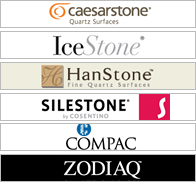Natural Rocks
Naturally occurring rocks can be further divided into three categories, which are based on the sequence processes of formation that the minerals had to go through and ultimately creating these natural masterpieces.
Once extracted from the ground, for the most part they arrive from the quarry prefabricated with high gloss finish, as this brings out the vibrant colors and beauty of the stone. However, we can also custom order, or convert, the surface to have other finishes, such as honed, flamed, brushed or sandblasted.
A different finish may be simply preferred for its visual appearance or for a more practical reason. For instance, it is very common to flame granite for exterior stairs or pathways, due to the fact that a polished surface would be extremely slippery rendering it dangerous to walk on, especially in bad weather.
Brushing, on the other hand, became very popular as a counter top finish due to the visual and practical benefits. The following is a very elementary breakdown of the three types of natural rocks:
- Igneous, in this industry commonly referred to as granite. However, there are dozens of subtypes which are classified as such. They were formed due to cooling of the molten magma which followed volcano eruptions, over a span of millions of years.
Out of all the natural stones, this would be the most commonly chosen material for surfaces which have to stand up to the task where there is often a lot of traffic and frequent usage. In case of residential applications, out of all of the natural stones, it would be the number one choice for kitchen counter tops. - Sedimentary such as travertine, limestone or sandstone generally describe rocks which were formed by accumulation of clastic (pre-existing rock) sediments, organic matter or water-soluble minerals.
These types of stones usually form right on or very near, to the Earth’s surface. They are much softer and often very porous. Generally used for less demanding applications, due to high probability of being scratched or stained. - Metamorphic rocks. Two most common examples being marble and slate. These stones are the result of change which has occurred to an igneous or sedimentary rock due to very high heat and pressure. Although these transformations occurred deep inside the earth’s crust, due to erosion and tectonic uplifts they can be commonly found on the Earth’s surface.
Similarly to sedimentary rocks, these are usually also very soft and not practical for heavy duty applications.
Due to their beauty they usually are utilized as bathroom accents in form of vanity tops, shower jambs, and other items of similar application.










